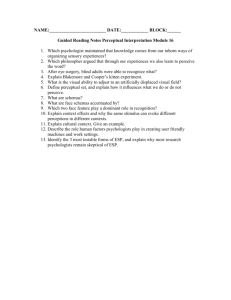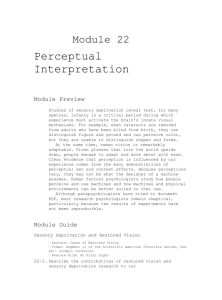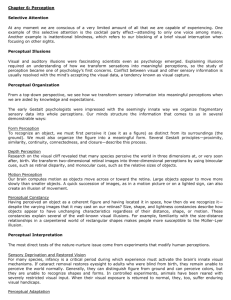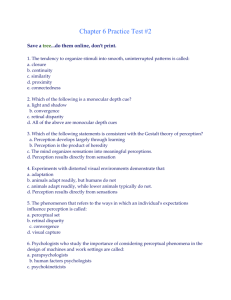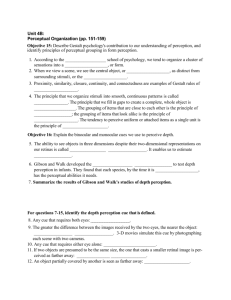Perceptual Interpretation
advertisement
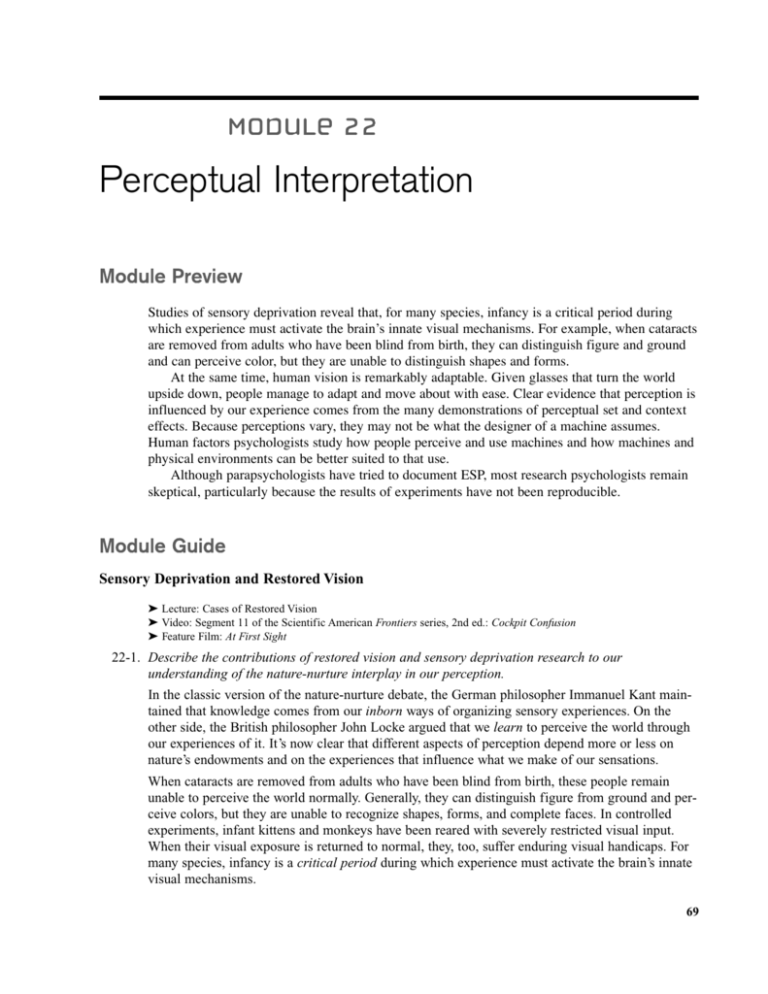
Perceptual Interpretation Studies of sensory deprivation reveal that, for many species, infancy is a critical period during which experience must activate the brain’s innate visual mechanisms. For example, when cataracts are removed from adults who have been blind from birth, they can distinguish figure and ground and can perceive color, but they are unable to distinguish shapes and forms. At the same time, human vision is remarkably adaptable. Given glasses that turn the world upside down, people manage to adapt and move about with ease. Clear evidence that perception is influenced by our experience comes from the many demonstrations of perceptual set and context effects. Because perceptions vary, they may not be what the designer of a machine assumes. Human factors psychologists study how people perceive and use machines and how machines and physical environments can be better suited to that use. Although parapsychologists have tried to document ESP, most research psychologists remain skeptical, particularly because the results of experiments have not been reproducible. Sensory Deprivation and Restored Vision ➤ Lecture: Cases of Restored Vision ➤ Video: Segment 11 of the Scientific American Frontiers series, 2nd ed.: Cockpit Confusion ➤ Feature Film: At First Sight 22-1. Describe the contributions of restored vision and sensory deprivation research to our understanding of the nature-nurture interplay in our perception. In the classic version of the nature-nurture debate, the German philosopher Immanuel Kant maintained that knowledge comes from our inborn ways of organizing sensory experiences. On the other side, the British philosopher John Locke argued that we learn to perceive the world through our experiences of it. It’s now clear that different aspects of perception depend more or less on nature’s endowments and on the experiences that influence what we make of our sensations. When cataracts are removed from adults who have been blind from birth, these people remain unable to perceive the world normally. Generally, they can distinguish figure from ground and perceive colors, but they are unable to recognize shapes, forms, and complete faces. In controlled experiments, infant kittens and monkeys have been reared with severely restricted visual input. When their visual exposure is returned to normal, they, too, suffer enduring visual handicaps. For many species, infancy is a critical period during which experience must activate the brain’s innate visual mechanisms. 69 70 Module 22 Perceptual Interpretation Perceptual Adaptation ➤ Exercise: Displacement Glasses ➤ Video: Module 10 of The Brain series, 2nd ed.: Perception: Inverted Vision ➤ Instructor Video Tool Kit: Sensing the World Upside Down 22-2. Explain how the research on distorting goggles increases our understanding of the adaptability of perception. Human perception is remarkably adaptable. Given glasses that shift the world slightly to the left or right, or even turn it upside down, people manage to adapt their movements and, with practice, to move about with ease. ➤ Lecture: “Thin-Slicing” ➤ Exercises: Discovering Personal Bias; Perceptual Set; Social Transmission of a Narrative; Perceptual Set and Gender Stereotypes; Context and Perception 22-3. Define perceptual set, and explain why the same stimulus can evoke different perceptions in different contexts. Clear evidence that perception is influenced by our experiences—our learned assumptions and beliefs—as well as by sensory input comes from the many demonstrations of perceptual set, a mental predisposition to perceive one thing and not another. Through experience, we also form concepts, or schemas, which organize and interpret unfamiliar information, a fact that helps explain why some of us “see” monsters, faces, and UFOs that others do not. A given stimulus may trigger radically different perceptions, partly because of our different schemas, but also because of the immediate context. For example, we discern whether a speaker said “morning” or “mourning” or “dye” or “die” from the surrounding words. Perceptions are influenced, top-down, not only by our expectations and by the context but also by our motivations and emotions. Perception and the Human Factor Lectures: Bad Human Designs; Banner Blindness and Web Design 22-4. Describe the role human factors psychologists play in creating user-friendly machines and physical environments. Human factors psychologists explore how people and machines interact and how machines and physical environments can be made safe and easy to use. They help to design appliances, machines, and work settings that fit our natural perceptions and inclinations. Understanding human factors helps to prevent accidents and avoid disaster. As psychologists, their most powerful tool is theory-aided research. By testing users’ responses to several alternatives, they seek to increase both human safety and productivity. Human factors psychologists are mindful of the “curse of knowledge,” whereby technology developers assume that others share their expertise. Module 22 Perceptual Interpretation 71 Is There Extrasensory Perception? ➤ ➤ ➤ ➤ ➤ Lecture: Belief in ESP Exercises: Belief in ESP Scale; ESP Tricks Project: The Psychic Challenge Project/Exercise: Testing for ESP Video: Segment 2 of the Scientific American Frontiers series, 2nd ed.: Water, Water Everywhere 22-5. Identify the three most testable forms of ESP, and explain why most research psychologists remain skeptical of ESP claims. Claims are made by parapsychologists for three varieties of extrasensory perception (ESP): telepathy (mind-to-mind communication), clairvoyance (perceiving remote events), and precognition (perceiving future events). Closely linked with these are claims of psychokinesis (PK), or “mind over matter.” Research psychologists remain skeptical because the forecasts of “leading psychics” reveal meager accuracy, because checks of psychic visions have been no more accurate than guesses made by others, and because sheer chance guarantees that some stunning coincidences are sure to occur. An important reason for their skepticism, however, is the absence of a reproducible ESP result.
